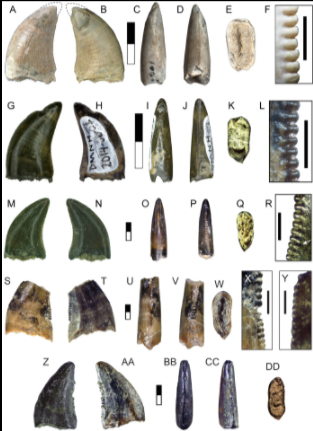Domenic C. D’Amore, associate professor of biology, co-authored a research paper published in the journal PeerJ, that examined fossil fragments of dinosaur teeth.
Some of the fossils represent the first occurrence of such species in what is now the eastern United States.
“By evaluating these loose teeth, we’re able to figure out what animals were alive, where and when—and what they ate,” said D’Amore. “This information also provides a broader understanding of the plant and animal diversity that was present in this part of the world, millions of years ago.”
The fossils hail from the Lewisville Formation—located in what’s now Texas, between Dallas and Ft. Worth—and date back to 95 to 100 million years ago. Back then, a water body—the Western Interior Seaway—divided modern day North America into two parts: Laramidia to the west and Appalachia in the east.
In Appalachia, vertebrate fossils—such as ones from the dinosaurs in this study—are rare and consist mostly of isolated and fragmentary remains, which make the teeth analyzed in the paper all the more significant.
D’Amore, who studies the anatomy of dinosaur teeth, has published research on their size and shape—and how teeth marks can provide information about dinosaur behavior. Even a single tooth can provide a wide range of information, he explained.
The fossils in this study are from species that were a range of sizes, including a large-bodied carcharodontosaur, a mid-sized tyrannosauroid, a small dromaeosaurid, and others.
Researchers found that the species in Appalachia were similar to those in Laramidia, which means they were widespread across the continent prior to its full division by the seaway.
The fossils themselves were excavated in the past, but they had not been analyzed in a rigorous manner up until this point due to their non-pristine condition.
“The fossils are not great but that doesn’t mean they’re useless,” said D’Amore. “By analyzing them with modern methods, we’re filling in gaps of knowledge of what the environment and fauna were like at this time.”
He added, “as there are additional digs and studies, gaps in knowledge will be filled in even more.”
Other co-authors included Christopher Noto, of University of Wisconsin-Parkside; Stephanie Drumheller, of the University of Tennessee; and Thomas Adams, with the Witte Museum in San Antonio.


